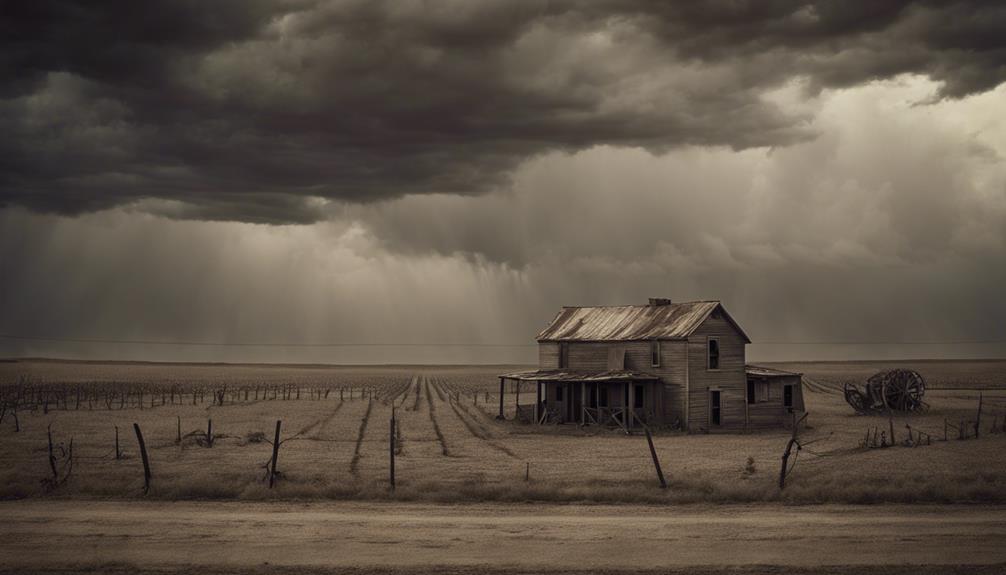Explore the impactful tale of 'The Grapes of Wrath,' showcasing the Joad family's journey from the Dust Bowl to California amidst the Great Depression. Characters like Tom Joad and Ma Joad embody strength and unity, delving into themes of resilience, capitalism's cruelty, and the pursuit of a better life. Uncover symbolism like the title's wrathful connotation and the religious imagery woven throughout, shedding light on social injustices and human experiences. Discover how Steinbeck's masterpiece weaves a narrative of sacrifice, redemption, and the enduring spirit of humanity in the face of adversity. Dive deeper into this timeless classic's layers of meaning.
Plot Overview
In 'The Grapes of Wrath', the Joad family's journey unfolds against the backdrop of the Great Depression, showcasing themes of resilience and social injustice. Tom Joad, the protagonist, leads his family from the Dust Bowl of Oklahoma to California, seeking a better life as migrant workers. However, upon reaching California, they're met with harsh living conditions, exploitation, and discrimination, highlighting the prevalent social injustices of the time.
The Joad family's struggles in California serve as a microcosm for the larger societal issues faced by migrant workers during the Great Depression. Steinbeck vividly portrays the challenges and adversities they endure, shedding light on the harsh realities of poverty and labor exploitation.
Through their experiences, the novel explores the systemic injustices that marginalized communities faced, emphasizing the resilience and unity within the Joad family as they confront these oppressive forces. The narrative powerfully captures the spirit of endurance in the face of overwhelming hardship, resonating with readers on a deeply human level.
Main Characters
You'll discover the key players in 'The Grapes of Wrath' who shape the narrative with their diverse personalities and struggles.
Their development throughout the story offers deep insights into themes of resilience, sacrifice, and community.
Examining their individual impacts on the overarching plot reveals the intricate web of human experiences that Steinbeck masterfully weaves.
Key Characters Overview
Explore the diverse and dynamic main characters in Steinbeck's 'The Grapes of Wrath,' each embodying unique qualities and facing profound challenges during the Great Depression.
The Joads, a family at the center of the novel, navigate the harsh realities of the era with resilience and unity. Tom Joad, the protagonist, transforms into a resilient family leader, while Ma Joad stands as the unwavering matriarch symbolizing strength and determination.
Jim Casy, a former preacher turned labor organizer, embodies selflessness and sacrifice as he fights for justice. Rose of Sharon undergoes a remarkable personal journey from self-centeredness to selflessness, reflecting the evolution of the human spirit amidst adversity.
Pa Joad, the family's pillar of strength, experiences a decline in resilience as he grapples with the challenges brought on by the Great Depression. Together, these characters form a tapestry of human experience, illustrating the complexities of survival and transformation in times of hardship.
Character Development Analysis
Now, analyzing the character development of the main characters in 'The Grapes of Wrath' reveals the profound transformations they undergo amidst the challenges of the Great Depression.
The Joad family members evolve greatly throughout the novel. Tom Joad evolves from an ex-convict to a resilient family protector and advocate for the oppressed, showcasing remarkable growth.
Ma Joad serves as the emotional rock of the family, displaying unwavering strength and determination in the face of adversity, embodying the resilience of migrant workers.
Jim Casy, a former preacher, transforms into a selfless figure leading a strike for peach pickers, guiding others morally.
Pa Joad experiences a decline in strength, mirroring the struggles of migrant workers in the 1930s.
Rose of Sharon undergoes a critical transformation from self-centeredness to selflessness, symbolizing personal growth and empathy, highlighting the capacity for empathy and selflessness in the most challenging times.
Impact on Story
The main characters in 'The Grapes of Wrath' greatly influence the story's narrative through their transformative journeys and impactful roles. Tom Joad's resilience and transformation from an ex-convict to a family protector shift the family dynamics, showcasing his leadership qualities.
Ma Joad, as the emotional anchor and protector, embodies strength and determination, holding the family together during hardships. Jim Casy's moral guidance and self-sacrifice in organizing strikes for better conditions shape the family's journey towards justice.
Rose of Sharon's personal growth from self-centeredness to selflessness reflects pivotal moments of change, impacting the family's trajectory. Meanwhile, Pa Joad's diminishing strength amid challenges mirrors the family's struggles, illustrating the shifting dynamics within the Joad family unit.
Each character's unique journey and role contribute to the overarching narrative of resilience, family bonds, and the pursuit of a better life during the Great Depression.
Key Themes Explored

Several key themes are intricately woven throughout Steinbeck's classic 'The Grapes of Wrath,' shedding light on the struggles and triumphs of individuals during the Great Depression.
The novel explores the experiences of migrant workers, highlighting the social injustice and economic inequality they faced.
Through the lens of family unity, Steinbeck portrays the resilience and strength of the human spirit in the face of labor exploitation and adversity.
The narrative critiques the inhumanity of capitalism and examines themes of sacrifice, redemption, and the pursuit of a better life.
Steinbeck's examination of these themes underscores the enduring struggles of marginalized communities and the fight for justice.
The characters' journey reflects the anger and determination of those oppressed by societal structures, emphasizing the importance of solidarity and perseverance in the face of hardship.
'The Grapes of Wrath' ultimately serves as a poignant reminder of the power of hope and the resilience of the human experience.
Symbolism in the Novel
Symbolism in 'The Grapes of Wrath' imbues the narrative with layers of meaning and depth, enriching your understanding of the novel's themes.
The title itself, 'The Grapes of Wrath,' symbolizes both anger and divine justice in the face of social injustice.
Throughout the story, the Joad family's journey mirrors biblical narratives, drawing parallels to the Israelites' exodus from Egypt.
Characters like Tom Joad and Jim Casy serve as Christ-like figures, embodying themes of sacrifice and redemption.
The novel's use of religious imagery and references, such as the Battle Hymn of the Republic, further enhances its religious interpretation.
This symbolism underscores themes of wrath, suffering, and the resilience of the human spirit in the midst of adversity.
Steinbeck masterfully weaves these elements together to create a powerful narrative that not only tells the story of the Joad family but also reflects on broader ideas of divine justice and the human experience.
Social Commentary

Steinbeck's exploration of societal structures in 'The Grapes of Wrath' exposes the harsh realities faced by migrant workers during the Great Depression. Through his narrative, Steinbeck delves into the intricacies of labor exploitation and social injustice experienced by the working class.
The novel serves as a poignant commentary on the economic inequality prevalent during that era, shedding light on the struggles of those marginalized by commercial interests. Steinbeck's portrayal of migrant workers captures the resilience and unwavering spirit of individuals amidst adversity, emphasizing the need for empathy and social change.
Impact and Legacy
The impact and legacy of 'The Grapes of Wrath' are undeniable.
The novel's lasting cultural influence is evident in its Pulitzer Prize win and numerous adaptations across different mediums.
Its powerful social justice themes continue to resonate with audiences today, solidifying its place as a significant piece of American literature.
Lasting Cultural Influence
The enduring impact of 'The Grapes of Wrath' on culture is palpable through its themes of social justice, family resilience, and economic struggle. The Joads, a family of tenant farmers, symbolize the plight of workers during the Great Depression as they migrate to California in search of a better life. Steinbeck's realist novel sheds light on the harsh realities of economic hardship and the resilience of families facing adversity, resonating with audiences then and now.
The novel's influence extends beyond literature, with adaptations like the 1940 film and stage productions further embedding its legacy in popular culture. Musicians such as Bruce Springsteen and Rage Against the Machine have channeled the novel's themes into their music, using it as a platform for social commentary.
Despite facing criticism, 'The Grapes of Wrath' continues to spark societal discussions and inspire artistic expression, cementing its place in American cultural history.
Social Justice Themes
Amidst ongoing societal struggles, the social justice themes of 'The Grapes of Wrath' continue to resonate deeply with readers and activists alike. Steinbeck's portrayal of Tom Joad and the Joad family's fight against labor exploitation, economic inequality, and the quest for fair labor practices strikes a chord with those advocating for workers' rights. By shedding light on the hardships faced by migrant workers and exposing systemic inequalities, the novel sparks conversations on social issues and inspires activism for marginalized communities.
The legacy of 'The Grapes of Wrath' lies in its ability to amplify themes of solidarity, resilience, and the battle against oppression, which remain relevant in today's pursuit of social justice. Through its vivid depiction of social injustices, the novel serves as a powerful tool for challenging societal norms and advocating for a more just and equitable world.
In a landscape shaped by ongoing struggles for fairness and equality, the lessons from 'The Grapes of Wrath' continue to influence movements towards a more inclusive society.
Literary Awards Received
Steinbeck's Pulitzer Prize-winning novel, 'The Grapes of Wrath,' holds a prominent place in American literary history. The novel's accolades, including the Pulitzer Prize for Fiction in 1940 and the National Book Award, underscore its literary excellence and social impact. These prestigious awards solidified 'The Grapes of Wrath' as a significant work in American literature, elevating its visibility and cementing its legacy as a classic piece of writing.
The recognition through these accolades highlights the enduring relevance of John Steinbeck's novel, which continues to be studied in academic settings. Its status as a benchmark for social commentary in fiction further emphasizes its influence on readers and scholars alike. By receiving such honors, 'The Grapes of Wrath' not only showcases Steinbeck's literary prowess but also reaffirms its place as a timeless piece that resonates with audiences across generations.
Critical Analysis

Within 'The Grapes of Wrath,' a profound exploration of societal structures emerges through Steinbeck's narrative lens.
The Joads, emblematic of countless migrant workers during the Great Depression, face relentless labor exploitation and social injustice. Steinbeck skillfully weaves a narrative that shines a spotlight on the human suffering and resilience of those marginalized by society.
The novel's socialist undertones and critique of capitalism sparked both acclaim and controversy upon its release. Through vivid imagery and symbolism, Steinbeck delivers a poignant message on solidarity and the enduring spirit of those facing adversity.
'The Grapes of Wrath' continues to resonate due to its unflinching portrayal of the human experience and its lasting impact on American literature and culture. Steinbeck's masterful critique of the societal norms of his time remains as relevant today as it was during the era of the Great Depression.
Literary Style
The literary style employed in 'The Grapes of Wrath' by John Steinbeck vividly captures the harsh realities of the Great Depression. Steinbeck's naturalistic approach in the novel portrays human struggles against social and economic forces beyond their control.
Through the use of symbolism and allegory, deeper themes such as biblical parallels and social commentary are enhanced. Dialogue within the narrative plays an essential role in revealing the characters' emotions, relationships, and the societal issues they face.
The author's prose, blending realism and lyricism, creates a powerful and evocative portrayal of the Joad family's journey and the broader socio-economic landscape of the era. Steinbeck's meticulous attention to detail and his ability to intertwine these elements seamlessly contribute to the rich tapestry of 'The Grapes of Wrath'.
Setting and Atmosphere

The backdrop of economic struggle and societal upheaval in 'The Grapes of Wrath' envelops the characters in a harsh and unforgiving environment. Set against the Dust Bowl devastation in Oklahoma during the Great Depression, the Joads and other migrant families face profound challenges. Steinbeck masterfully portrays the bleak landscape, emphasizing the Dust Bowl's desolation and the pervasive sense of economic hardship. The novel vividly captures the harsh realities of socio-economic challenges, showcasing the migrant struggles and injustices prevalent during that era.
Through atmospheric details, Steinbeck paints a picture of despair and uncertainty, highlighting the profound resilience of the human spirit amidst adversity. The setting not only serves as a backdrop but also shapes the characters' experiences, underscoring the struggles and hardships they endure.
As the Joad family sets out on their journey, the unforgiving environment mirrors the societal injustices they face, creating a poignant narrative that resonates with readers.
The Joad Family Journey
Setting out on a treacherous journey to California during the Great Depression, the Joad family faces a multitude of challenges and hardships. As tenant farmers uprooted by economic hardship and societal injustice, the Joads seek refuge in the promise of California's fruit-picking jobs.
Along the way, their journey is marred by tragedy, betrayal, and selfless acts within the family. Despite their unity and resilience, the Joads encounter hostility, exploitation, and discrimination in California, painting a bleak picture of the harsh realities faced by migrant workers during that era.
- The Joad family, led by Tom Joad, sets out from Oklahoma seeking a better life in California.
- Along the journey, family members such as Grandpa and Granma pass away, reflecting the toll of their hardships.
- The Joads are confronted with unfair labor practices and discrimination in California, challenging their hopes for a brighter future.
- Despite the adversities faced, the Joad family's unwavering bond and determination to survive symbolize the resilience of the human spirit amidst adversity.
Conclusion
Now that you've explored 'The Grapes of Wrath,' you can see how Steinbeck's powerful storytelling weaves together themes of struggle, resilience, and hope.
The Joad family's journey serves as a poignant reminder of the hardships faced by many during the Great Depression. Through vivid imagery and compelling characters, Steinbeck's classic novel continues to resonate with readers, offering a timeless portrayal of the human experience.
So immerse yourself and experience the depth and beauty of this literary masterpiece.



